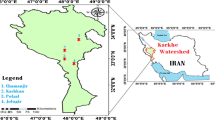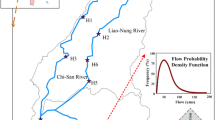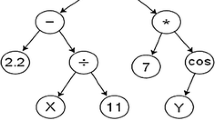Abstract
Many river networks are controlled by sluices, especially in plain area. To prevent potential floods, maintain water level, and improve water environment in the inner river, the water transfer of river networks is needed and executed often in terms of optimized operation rules of sluices planned in advancing. To guarantee maintaining the optimized operation status, the provision of appropriate operating framework of sluices in river networks is necessary and presented in this study based on the knowledge-driven and data-driven mechanism. The general framework is formed by River Networks Mathematical Model (RNMM), Artificial Neural Networks (ANN) and Genetic Algorithms (GA), in which, ANN is used to build a rapid simulation of the flow variables in river networks, RNMM is used to train the ANN model, and GA method, whose fitness function is constructed by the ANN model, is used to optimize the operation rules of sluices. As a demonstration, the framework was applied to water transfer project of the tidal river networks locating in Pudong New Area of Shanghai in mainland China. Firstly, RNMM of Pudong was built and validated according to observed data during water transfer tests. Then, the Backward Propagation Neural Networks (BPNN) model was established as the fast simulation tool of flow variables of river networks through the numerical experiments with RNMM. The Generalized Genetic Algorithms (GGA) was recommended as optimization algorithm of sluices operation rules. Through comparing the optimization results with the RNMM simulation outputs under eight cases, it is verified that the framework can offer sub-optimal operation rules of sluices in river networks and present excellent speediness, robustness and flexibility. It is encouraged to be applied to more complicated, practical problems.






Similar content being viewed by others
References
Achievements report of water resources census in Pudong New Area (2002) Joint meeting on water resources census in Pudong New Area. Shanghai Scientific & Technical Literature Publishing House, Shanghai (In Chinese)
Annual tidal table of Shanghai Harbor and Hangzhou Bay (2008) Shanghai maritime safety administration. China Communications Press, Beijing (In Chinese)
Bouwer H (2002) Integrated water management for the 21st century: problems and solutions. J Irrig Drain Eng 128(4):193–202
Cancelliere A, Giullano G, Ancarani A, Rossi G (2002) A neural networks approach for deriving irrigation reservoir operating rules. Water Resour Manag 16(1):71–88
Chan SN, Thoe W, Lee JHW (2013) Real-time forecasting of Hong Kong beach water quality by 3D deterministic model. Water Res 47(4):1631–1647
Chen XH, Chen YQD (2004) Human-induced hydrological changes in the river network of the Pearl River Delta, South China. In: IAHS-AISH Publication (289). IAHS Press, pp 197–205
de Brye B, de Brauwere A, Gourgue O, Kärnä T, Lambrechts J, Comblen R, Deleersnijder E (2010) A finite-element, multi-scale model of the scheldt tributaries, river, estuary and ROFI. Coast Eng 57(9):850–863
Dibike YB, Abbott MB (1999) Application of artificial neural networks to the simulation of a two dimension flow. J Hydraul Res 37(4):435–446
Dibike YB, Olomatine D, Abbott MB (1999) On the encapsulation of numerical-hydraulic models in artificial neural network. J Hydraul Res 37(2):147–161
Gu ZH (2004) Study on theory and application of intelligent flow simulation. the doctorate dissertations of Hohai University. Nanjing, China (In Chinese)
Gu ZH (2006a) Study on intelligent operation aided decision-making model of sluices in river networks. Journal of Zhejiang University, ISSN: 1008973X, 40 (5): 822–26, doi: 1008-973X (2006) 05-0822-05, http://www.journals.zju.edu.cn/eng
Gu ZH (2006b) Generalized genetic algorithms and its application to identifying flow parameters. Xitong Gongcheng Lilun yu Shijian 26(2):133–137
Gu ZH, Dong ZY (2008) Intelligent identification on hydraulic parameters of ship lock based generalized genetic algorithms. In: Proceedings-international conference on intelligent computation technology and automation, ICICTA 2008. Changsha, China, pp 1082–1086
Gu ZH, Liu GP, Tang HW, Zhou YL (2007) Study on numerical simulation of water transfer process in tidal river networks. Journal of Hydroelectric Engineering, ISSN: 10031243, 26 (4): 76–81, http://caod.oriprobe.com/order.htm?id=475618&ftext=base
Gu ZH, Xu XD, Cao XM, Liu W (2013) Calculation of total water diversiton quantity of tidal river network in water quantity regulation. Ren Min Chang Jiang 44(11):23–26
Habib EH, Meselhe EA (2006) Stage–discharge relations for low-gradient tidal streams using data-driven models. J Hydraul Eng 132(5):482–492
Han Y, Xu SG, Xu XZ (2008) Modeling multisource multiuser water resources allocation. Water Resour Manag 22(7):911–923
István A (1998) Combining a neural network and a numerical flow model in system identification. http://citeseerx.ist.psu.edu/viewdoc/download?doi=10.1.1.18.212&rep=rep1&type=pdf, accessed 10 February 2013
Jia HF, Yang C, Zhang YH, Chen YR (2013) Simulations of a water quality improvement for urban river networks. Qinghua Daxue Xuebao 53(5):665–672, 728 (In Chinese)
Jin JL, Yang XH, Ding J (2001) An improved simple genetic algorithm - accelerating genetic algorithm. Xitong Gongcheng Lilun yu Shijian 21(4):8–13 (In Chinese)
Johnson AR, Hatfield CA, Milne BT (1995) Simulated diffusion dynamics in river networks. Ecol Model 83(3):311–325
Kumphon B (2013) Genetic algorithms for multi-objective optimization: application to a multi-reservoir system in the Chi River Basin, Thailand. Water Resour Manag 27(12):4369–4378
Kuo SF, Liu CW, Chen SK (2003) Comparative study of optimization techniques for irrigation project planning. J Am Water Resour Assoc 39(1):59–73
Lee JHW, Qu B (2004) Hydrodynamic tracking of the massive spring 1998 red tide in Hong Kong. J Environ Eng 130(5):535–550
Liu XD, Zhou YY, Hua ZL, Chu KJ, Wang P, Gu L, Chen LQ (2014) Parameter identification of river water quality models using a genetic algorithm. Water Sci Technol 69(4):687–693
Lobbrecht AH, Dibike YB, Solomatine DP (2002) Applications of neural networks and fuzzy logic to integrated water management. Project report. IHE-Delft, the Netherlands
Neubauer A (2010) Theory of the simple genetic algorithm with α-selection, uniform crossover and bitwise mutation. WSEAS Trans Syst., ISSN: 11092777, E-ISSN: 2224–2678, 9 (9): 989–998, http://www.worldses.org/journals/systems/systems-2010.htm, Elsevier Inc.
Ozdemir ON, Uçaner ME (2005) Success of booster chlorination for water supply networks with genetic algorithms. J Hydraul Res 43(3):267–275
Panda RK, Pramanik N, Bala B (2010) Simulation of river stage using artificial neural network and MIKE11 hydrodynamic model. Comput Geosci 36(6):735–745
Price RK, Samedov JN, Solomatine DP (1998) An artificial neural network model of a generalised channel network. In: Proceedings of the 3rd international conference on hydroinformatics. Copenhagen, Denmark
Wu CL, Chau KW, Li YS (2009) Predicting monthly streamflow using data-driven models coupled with data-preprocessing techniques. Water Resour Res 45(8):1–23. doi:10.1029/2007WR006737, W08432
Xu XM, He JJ, DG W (2001) Nonlinear method on large scale river networks unsteady flow. Shuidonglixue Yanjiu yu Jinzhan 16(1):18–24 (In Chinese)
Zhu DJ, Chen YC, Wang ZY, Liu ZW (2011) Simple, robust, and efficient algorithm for gradually varied subcritical flow simulation in general channel networks. J Hydraul Eng 137(7):766–774
Acknowledgments
The project supported by Hong Kong RGC-GRF Grant (CityU 118212), Strategic research grant, City University of Hong Kong [Projects No. CityU-SRG 7002718], National Natural Science Foundation of China (Grant No. 50909085) & Science and Technology Project of DWRZJ (Grant No. RC1106).
Author information
Authors and Affiliations
Corresponding author
Rights and permissions
About this article
Cite this article
Gu, Z., Cao, X., Liu, G. et al. Optimizing Operation Rules of Sluices in River Networks Based on Knowledge-driven and Data-driven Mechanism. Water Resour Manage 28, 3455–3469 (2014). https://doi.org/10.1007/s11269-014-0679-y
Received:
Accepted:
Published:
Issue Date:
DOI: https://doi.org/10.1007/s11269-014-0679-y




